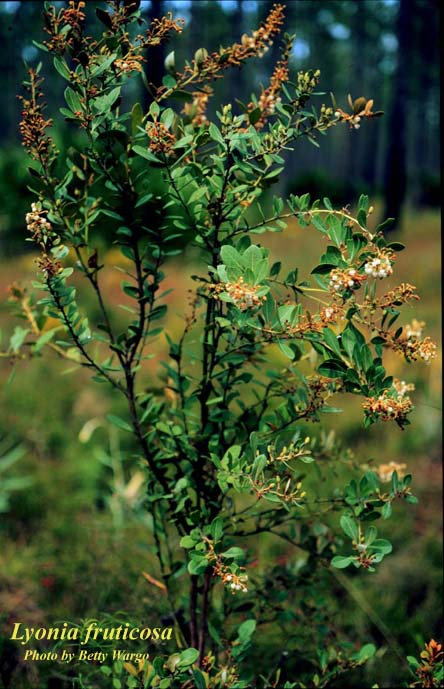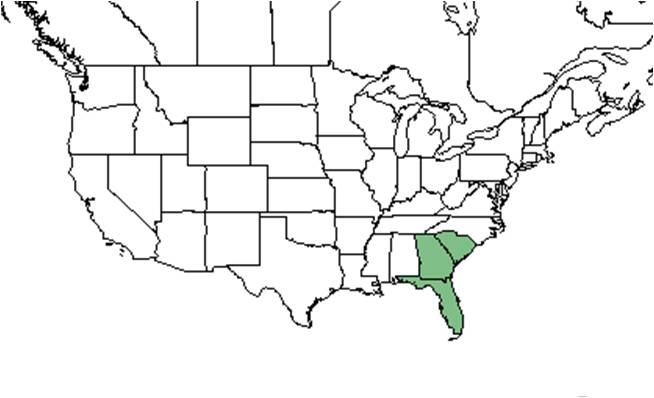Difference between revisions of "Lyonia fruticosa"
KatieMccoy (talk | contribs) (→Taxonomic notes) |
|||
| Line 20: | Line 20: | ||
Common name: coastal plain staggerbush | Common name: coastal plain staggerbush | ||
==Taxonomic notes== | ==Taxonomic notes== | ||
| + | The genus ''Lyonia'' is named for John Lyon a 19th century botanist who is best known for his travels in southern Appalachians <ref name="treasurecoast">[[https://treasurecoastnatives.wordpress.com/2014/01/18/fettered-staggering-and-getting-by/]] Treasure Coast Natives Accessed: February 9, 2016</ref>. | ||
| + | |||
==Description== | ==Description== | ||
<!-- Basic life history facts such as annual/perrenial, monoecious/dioecious, root morphology, seed type, etc. --> | <!-- Basic life history facts such as annual/perrenial, monoecious/dioecious, root morphology, seed type, etc. --> | ||
Revision as of 16:37, 8 February 2016
| Lyonia fruticosa | |
|---|---|

| |
| Photo by Betty Wargo, Atlas of Florida Vascular Plants | |
| Scientific classification | |
| Kingdom: | Plantae |
| Division: | Magnoliophyta - Flowering plants |
| Class: | Magnoliopsida – Dicotyledons |
| Order: | Ericales |
| Family: | Ericaceae |
| Genus: | Lyonia |
| Species: | L. fruticosa |
| Binomial name | |
| Lyonia fruticosa (Michx.) G.S. Torr. | |

| |
| Natural range of Lyonia fruticosa from USDA NRCS Plants Database. | |
Common name: coastal plain staggerbush
Contents
Taxonomic notes
The genus Lyonia is named for John Lyon a 19th century botanist who is best known for his travels in southern Appalachians [1].
Description
A description of Lyonia fruticosa is provided in The Flora of North America.
Distribution
Ecology
Habitat
In the Coastal Plain in Florida and Georgia, L. fruticosa can occur in pine flatwoods, pine-oak scrubs, pine/saw palmetto flats, Cyrilla swamps, cypress-gum swamps, shrub bogs, upland xeric sand pine/sand live oak communities, depression marshes, shore hammock, and mesic hardwood hammocks. It has been observed growing in abandoned dumps and slash pine plantations (FSU Herbarium). Substrates include loamy sand and white sand (FSU Herbarium). Associated species include Lyonia lucida, Ilex glabra, Myrica cerifera, Aronia, Sarracenia minor, Rhododendron, Kalmia, Hypericum, Serenoa repens, Agalinis and Sphagnum (FSU Herbarium).
Phenology
Flowers and fruits March through December (FSU Herbarium).
Seed dispersal
Seed bank and germination
Fire ecology
Pollination
The following Hymenoptera families and species were observed visiting flowers of Lyonia fruticosa at Archbold Biological Station (Deyrup 2015):
Apidae: Bombus impatiens
Colletidae: Colletes banksi, C. distinctus, C. productus, C. sp. A
Halictidae: Augochloropsis sumptuosa
Sphecidae: Stictia carolina
Vespidae: Monobia quadridens
Use by animals
Diseases and parasites
Conservation and Management
Cultivation and restoration
Photo Gallery
References and notes
Deyrup, M.A. and N.D. 2015. Database of observations of Hymenoptera visitations to flowers of plants on Archbold Biological Station, Florida, USA.
Florida State University Robert K. Godfrey Herbarium database. URL: http://herbarium.bio.fsu.edu. Last accessed: October 2015. Collectors: Loran C. Anderson, W.M.B., Edwin L. Bridges, Michael B. Brooks, Andre F. Clewell, Delzie Demaree, Angus Gholson, Robert K. Godfrey, Walter S. Judd, Robert Kral, O. Lakela, K. Lems, S.W. Leonard, Sidney McDaniel, Marc Minno, Richard S. Mitchell, R.A. Norris, C.W. O’Brien, Steve Orzell, Jackie Patman, Elmer C. Prichard, Gwynn W. Ramsey, James D. Ray, Grady Reinert, David Roddenberry, Cecil R. Slaughter, R.F. Thorne, E. Tyson, D.B. Ward, E. West, A.A. Will, Roomie Wilson. States and Counties: Florida: Alachua, Clay,Collier, Columbia, Duval, Flagler, Franklin, Gadsden, Gilchrist, Indian River, Jefferson, Lafayette, Leon, Levy, Liberty, Madison, Martin, Nassau, Okeechobee, Palm Beach, Pasco, Polk, Putnam, Sarasota, Taylor, Volusia, Wakulla. Georgia: Camden. Compiled by Tall Timbers Research Station and Land Conservancy.